
Fort Worth Museum of Science and History looks to evolve by continuing to educate, entertain guests
By Babs Rodriguez
Photos by Ralph Lauer
“Everyone has a museum story.” Fort Worth Museum of Science and History interim president Orlando Carvalho smiles broadly as he makes the comment. He leans forward to listen as I share how, more than 50 years ago, my little brother tightly gripped my hand in the semidarkness as we stared down a dramatically spotlighted depiction of a prehistoric brain surgery.
I have never forgotten the wow and wonder in that moment, and I am not alone. Carvalho says that the midcentury diorama made a well-received reappearance when the new museum building opened in 2009, rising on the footprint of its predecessor. Designed by Legorreta + Legorreta, an internationally known father-son team based in Mexico City, the monumental 166,000-square-foot facility was designed to hold its own with the architectural juggernauts of the Cultural District. The contemporary, geometric-cool architecture drew reviews both pro and con.
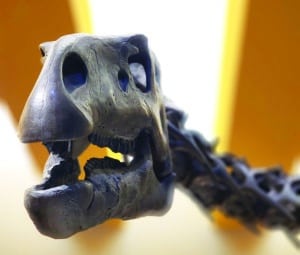
Exhibit at the Museum of Science and History in Fort Worth.
Carvalho understands that the sentimental appeal of the museum that so many grew up with created some resistance to change.
“Our response to nostalgia is an important part of what we do.” He believes that an emotional bond can become the bridge between treasured memories of museum visits and new experiences.
Of all the attractions in the Cultural District, the FWMSH (and its adjacent Museum School) weathered the hardest hit in attendance over the last few years. It took until June 2022 to fully open for business after the pandemic disruption and renovations required by damage from 2021’s deep freeze. Increased competition, including from Dallas’ Perot Museum of Nature and Science, which opened in late 2012, has not gone unstudied. Well aware of Fort Worth’s collective memory of the FWMSH as a “children’s museum” — despite decades of movement away from that moniker — Carvalho’s goal is to help create a new generation of fans of all ages.
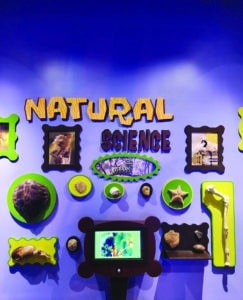
Exhibit at the Museum of Science and History in Fort Worth.
Carvalho who, with wife Anne and their three children, moved to Fort Worth in 2011 to join Lockheed Martin’s F-35 program (ultimately becoming executive vice president of the Aeronautics business area), fell hard for the community spirit of the city. In 2018, he and Anne chose to retire in Cowtown rather than return to Pennsylvania. The FWMSH board tapped him to temporarily hold the top job in April 2022, a year after longtime director Van Romans retired. Long a museum supporter, Carvalho (his wife stepped off the board when he stepped in) recognized his success required facilitating a very capable and experienced team that was already determined to perfect what the museum has always delivered: ongoing education and happy memories. “My focus here is to continue to move the museum forward, working with people who know what needs to be done.”
Joining us in a conference room, vice president of development Tammy McKinney and marketing coordinator Abigail Hofbauer also listen to the details of my recent museum visit with my now 25-year-old son. We built rockets, exclaimed over a well-remembered bed of nails and painted a dinosaur. When Elliott placed his size 11 foot inside a dinosaur track he once sat in, we were both delighted by the shared memory. I was happy to see “Astrid,” a life-size transparent woman filled with all the right stuff to study anatomy, who dates to my childhood visits. Elliott’s takeaway from the day: “It was so much fun. The nostalgia was part of that, but I was surprised to find myself learning new things.”
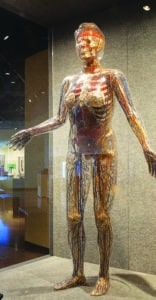
“Astrid,” still visits from time to time.
The women nod, and Carvalho exhales as if he’s been holding his breath. “What your son said is in line with our mission statement,” he says, pointing to a wall where the philosophy is spelled out. The gist: Learning never stops. It’s the same philosophy that inspired 16 female educators to launch the Fort Worth Children’s Museum, chartered in 1941 and opened on Summit Avenue in 1948. For 82 years, the institution has encouraged education by stimulating curiosity. The lessons first delivered in a turn-of-the-century house were easily transported to the hands-on, learning-through-play environment of the Montgomery Street building that opened in 1954 (the name was changed in 1968 to better reflect the museum’s depth). Educational engagement remains the pulse point of the museum’s bold and charmingly bright incarnation, too.

The retro food market from FWMSH’s last incarnation still attracts little kids to fill up miniature shopping carts as they wheel through the faux wares.
How the spaces within the building are used continues to evolve, Carvalho says. And mounting more exhibits drawn from deep collections related to Fort Worth and Texas history is a focus.
The finessing of existing exhibitions and interactive spaces is ongoing. The newly installed Galaxy Park outdoor playground, designed for children of all abilities, will gain much-needed awnings, additional seating and planetary projections early this year.

Playground at the Museum of Science and History in Fort Worth
The much-loved and field trip-friendly DinoDig will also gain sun protection and places for non-excavators to sit. The sprawling 10,000-square-foot (formerly XTO-sponsored) Energy Blast has already seen some updates involving sustainable energy options.
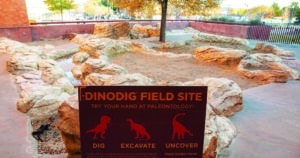
The popular DinoDig is getting some additional seating and shade.
Asked about special challenges the new president will face (candidates will be presented in January), Carvalho says a focus on more exhibits to entice adults to visit will continue, including some created in collaboration with other institutions. And while he wishes not to underplay the surprisingly diverse bounty of acquisitions in the museum’s deep collections — everything from Audubon drawings to Egyptian statuary — he says there is ongoing discussion on how best to ensure that what is displayed is compatible with the museum’s focus.
“Our rich collection of artifacts has a local resonance due to generations of donations from local collectors and gifts from estates, but we expect to concentrate future acquisitions on items more directly related to this part of the world.”
In January, expect the shape-shifting special exhibition galleries upstairs to display historic saddles and other Fort Worth Stock Show memorabilia along with a celebration of the 200th anniversary of the Texas Rangers. Playing host to world-class exhibitions begins in March with the Smithsonian National Museum of Natural History traveling exhibition “Life in One Cubic Foot.”
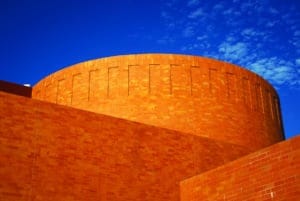
Taken at the Fort Worth Museum of Science and History.
Renovations are in progress on the beloved IMAX Omni Theater to make it ADA-compliant and more comfortable, as well as install upgraded technology. A large-scale exhibition related to the history of aviation in Fort Worth opens later this year, too.
Just know that whether you go to enjoy the technologically revamped Noble Planetarium, accompany a child into the museum-within-a-museum where the dragon jaws entry emulates the original Fort Worth Children’s Museum’s paper-mâché fire-breather, or introduce your family to Paluxysaurus Jonesi, the state dinosaur, you will at some point find yourself taken in by the architecture. The Urban Lantern is hard to miss, inside or out, with its sunny yellow stone walls rising 76 feet and crown of 97 glass panels each weighing 500 pounds. There are rivers of natural light and saturated colors, all signatures of the architects, that signal this isn’t your typical museum.
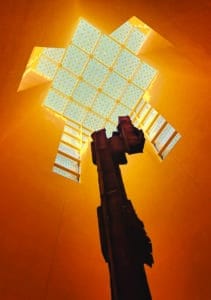
The Urban Lantern glows on sunny days; a twisted steel remnant of the World Trade Center is on display in the lobby.
The Heritage Courtyard features a coursing water feature, jacaranda blue walls and a heritage live oak whose 40-foot canopy is instantly familiar to generations of visitors.
The calming outdoor space was chosen by the architects to be the heart of the museum. It’s a good place to pause and reflect on the past, present and future of an institution looking to create fresh experiences — and to start collecting your own stories.
THE DETAILS
Fort Worth Museum of Science and History entrance fees vary by age and membership status. All admission prices include entrance to the Noble Planetarium and the in-house Cattle Raisers Museum. Note that grounds admission tickets to the Fort Worth Stock Show include entry to the museum. Usually closed on Mondays, the FWMSH is open seven days a week during the Stock Show. fwmuseum.org
